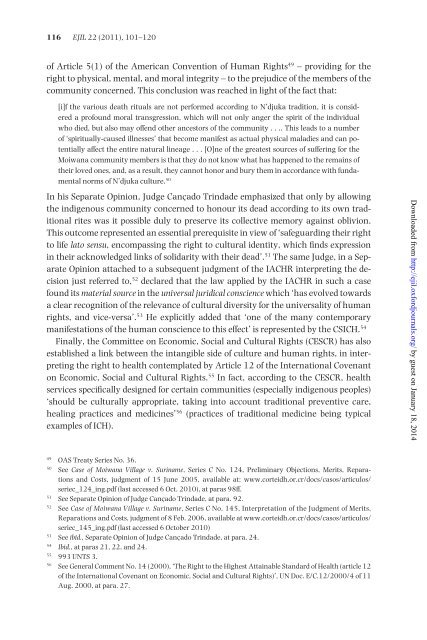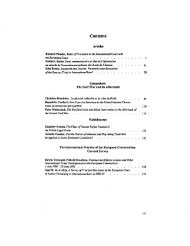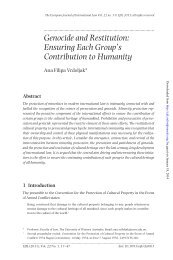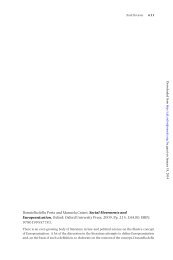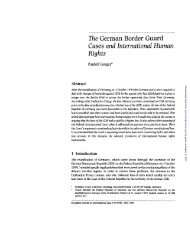Intangible Cultural Heritage - European Journal of International Law
Intangible Cultural Heritage - European Journal of International Law
Intangible Cultural Heritage - European Journal of International Law
Create successful ePaper yourself
Turn your PDF publications into a flip-book with our unique Google optimized e-Paper software.
116 EJIL 22 (2011), 101–120<br />
<strong>of</strong> Article 5(1) <strong>of</strong> the American Convention <strong>of</strong> Human Rights 49 – providing for the<br />
right to physical, mental, and moral integrity – to the prejudice <strong>of</strong> the members <strong>of</strong> the<br />
community concerned. This conclusion was reached in light <strong>of</strong> the fact that:<br />
[i]f the various death rituals are not performed according to N’djuka tradition, it is considered<br />
a pr<strong>of</strong>ound moral transgression, which will not only anger the spirit <strong>of</strong> the individual<br />
who died, but also may <strong>of</strong>fend other ancestors <strong>of</strong> the community . . .. This leads to a number<br />
<strong>of</strong> ‘spiritually-caused illnesses’ that become manifest as actual physical maladies and can potentially<br />
affect the entire natural lineage . . . [O]ne <strong>of</strong> the greatest sources <strong>of</strong> suffering for the<br />
Moiwana community members is that they do not know what has happened to the remains <strong>of</strong><br />
their loved ones, and, as a result, they cannot honor and bury them in accordance with fundamental<br />
norms <strong>of</strong> N’djuka culture. 50<br />
In his Separate Opinion, Judge Cançado Trindade emphasized that only by allowing<br />
the indigenous community concerned to honour its dead according to its own traditional<br />
rites was it possible duly to preserve its collective memory against oblivion.<br />
This outcome represented an essential prerequisite in view <strong>of</strong> ‘safeguarding their right<br />
to life lato sensu, encompassing the right to cultural identity, which finds expression<br />
in their acknowledged links <strong>of</strong> solidarity with their dead’. 51 The same Judge, in a Separate<br />
Opinion attached to a subsequent judgment <strong>of</strong> the IACHR interpreting the decision<br />
just referred to, 52 declared that the law applied by the IACHR in such a case<br />
found its material source in the universal juridical conscience which ‘has evolved towards<br />
a clear recognition <strong>of</strong> the relevance <strong>of</strong> cultural diversity for the universality <strong>of</strong> human<br />
rights, and vice-versa’. 53 He explicitly added that ‘one <strong>of</strong> the many contemporary<br />
manifestations <strong>of</strong> the human conscience to this effect’ is represented by the CSICH. 54<br />
Finally, the Committee on Economic, Social and <strong>Cultural</strong> Rights (CESCR) has also<br />
established a link between the intangible side <strong>of</strong> culture and human rights, in interpreting<br />
the right to health contemplated by Article 12 <strong>of</strong> the <strong>International</strong> Covenant<br />
on Economic, Social and <strong>Cultural</strong> Rights. 55 In fact, according to the CESCR, health<br />
services specifically designed for certain communities (especially indigenous peoples)<br />
‘should be culturally appropriate, taking into account traditional preventive care,<br />
healing practices and medicines’ 56 (practices <strong>of</strong> traditional medicine being typical<br />
examples <strong>of</strong> ICH).<br />
Downloaded from http://ejil.oxfordjournals.org/ by guest on January 18, 2014<br />
49<br />
OAS Treaty Series No. 36.<br />
50<br />
See Case <strong>of</strong> Moiwana Village v. Suriname, Series C No. 124, Preliminary Objections, Merits, Reparations<br />
and Costs, judgment <strong>of</strong> 15 June 2005, available at: www.corteidh.or.cr/docs/casos/articulos/<br />
seriec_124_ing.pdf (last accessed 6 Oct. 2010), at paras 98ff.<br />
51<br />
See Separate Opinion <strong>of</strong> Judge Cançado Trindade, at para. 92.<br />
52<br />
See Case <strong>of</strong> Moiwana Village v. Suriname, Series C No. 145, Interpretation <strong>of</strong> the Judgment <strong>of</strong> Merits,<br />
Reparations and Costs, judgment <strong>of</strong> 8 Feb. 2006, available at www.corteidh.or.cr/docs/casos/articulos/<br />
seriec_145_ing.pdf (last accessed 6 October 2010)<br />
53<br />
See ibid., Separate Opinion <strong>of</strong> Judge Cançado Trindade, at para. 24.<br />
54<br />
Ibid., at paras 21, 22, and 24.<br />
55<br />
993 UNTS 3.<br />
56<br />
See General Comment No. 14 (2000), ‘The Right to the Highest Attainable Standard <strong>of</strong> Health (article 12<br />
<strong>of</strong> the <strong>International</strong> Covenant on Economic, Social and <strong>Cultural</strong> Rights)’, UN Doc. E/C.12/2000/4 <strong>of</strong> 11<br />
Aug. 2000, at para. 27.


